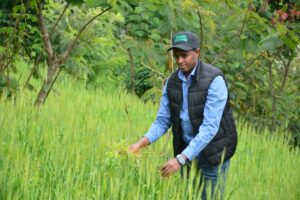Agroforestry in Gicumbi: Green Gicumbi Project restores land, boosts yields, and tackles Climate Change
Over the past five years, the Green Gicumbi project has been actively operating in Gicumbi District, implementing a wide range of initiatives focused on environmental protection, sustainable agriculture and livestock development, improved housing, and climate change adaptation.
The project covers nine sectors within the district, an area characterized by steep hills that have historically triggered environmental and agricultural challenges. These slopes contributed to soil erosion, leading to poor harvests and the gradual degradation of farmland with every rain droplets.
Jean Pierre Ngomitsinze, a farmer from Nyaruka Cell in Cyumba Sector, described the situation before the project’s interventions:
“Before the Green Gicumbi project came to support us, agriculture here offered little to nothing. Seeds were expensive, and the rains would wash everything away down the hills. Fertilizers didn’t last, and every season ended in losses.”
“These hills are steep, and we used to farm them as we pleased, not knowing that terracing and planting agroforestry trees was the sustainable solution we needed. We had started to think our land was no longer viable.”He added
To address this, the project introduced bench terraces to stabilize farmlands, preventing landslides and erosion. Fertilizer and crops would remain intact, and farmers began to see improved productivity.
Within these terraces, agroforestry trees like Calliandra, Sesbania (Risena), and others were planted. These species not only enrich the soil but also help combat erosion and pests. Their leaves provide organic fertilizer that decomposes quickly and offer livestock fodder. The trees also sequester harmful gases, playing a role in climate change mitigation.
Select it first 🌲https://vm.tiktok.com/ZMSaHJ6D6/🌿
Florence Mukandayisenga, a farmer in Cyumba Sector, explained:
“The trees planted among our crops helped stabilize our soils. We were taught that they provide manure, fresh air, and can be consumed by animals. We now see their real value through the increased yields we’re getting.”
The trees planted in farms are unique in that their roots do not compete with nearby crops. This agroforestry approach not only improved agricultural output but also helped the project meet its goal of expanding forest coverage to reduce heatwaves and deforestation.
Modeste Nsabimana, the head of Component Four of the Green Gicumbi Project (Training and Stakeholder Engagement), emphasized the multi-layered benefits:
“Species like Sesbania (Risena) and Calliandra offer numerous advantages from nourishing the soil to providing fodder. Their leaves decompose quickly and enrich the soil, creating better conditions for farming.”
“Where they are planted, they increase soil moisture by acting as mulch. Scientifically, they also help capture harmful gases (carbon sequestration), reduce erosion especially on steep slopes and provide support poles for climbing crops like beans.”He added
These agroforestry trees are now recognized as a long-term solution to land restoration, pest management, and climate resilience. The Green Gicumbi project has recorded increased yields among farmers since introducing them.
Over the past decade, the impact of climate change in Rwanda has worsened—bringing extreme weather such as floods, droughts, landslides, reduced crop yields, disease outbreaks, infrastructure damage, and shrinking arable land. This has led to food insecurity and reduced export volumes.
Rwanda’s heavy reliance on rainfall for farming, steep landscapes, limited access to climate information, and deforestation are among the key risk factors. A 2018 national report highlighted Northern Province particularly Gicumbi District—l as one of the most vulnerable areas to climate change impacts.
The Green Gicumbi Project operates in the following nine sectors: Rubaya, Cyumba, Kaniga, Mukarange, Rushaki, Shangasha, Manyagiro, Byumba, and Bwisige,all located within the Muvumba watershed. Across these sectors, 10,000 hectares of agroforestry trees have been planted, including intercropped trees ( Risena, Calliandra, Shirabuzi) and border trees (Gliricidia).
The project placed strong emphasis on building resilience to climate change, especially among vulnerable communities. It built 600 hectares of bench terraces, 850 hectares of progressive terraces, and 3,000 hectares of contour bunds planted with grasses and trees on hills with slopes over 55%.
Farmers were also supported with climate-resilient seeds and organic fertilizers, especially compost-based ones.


